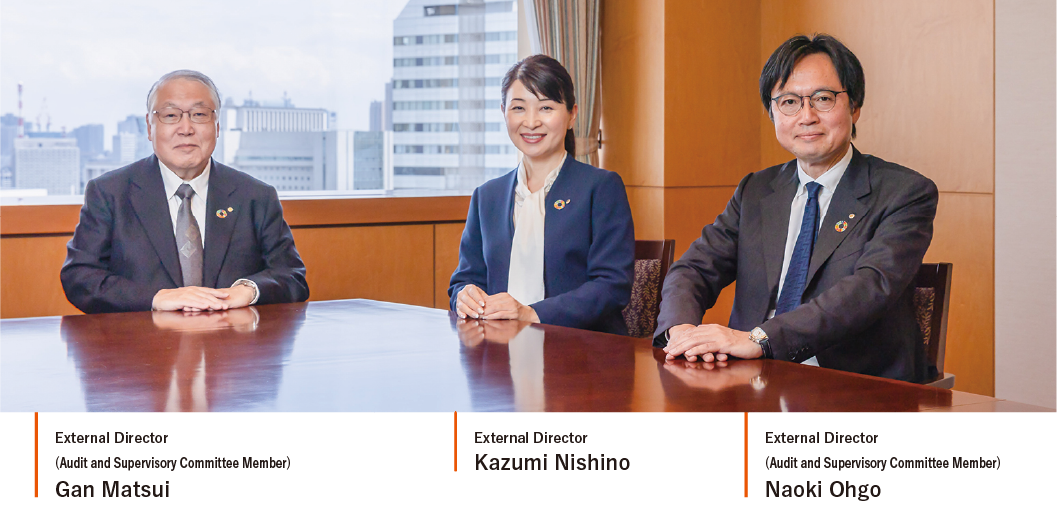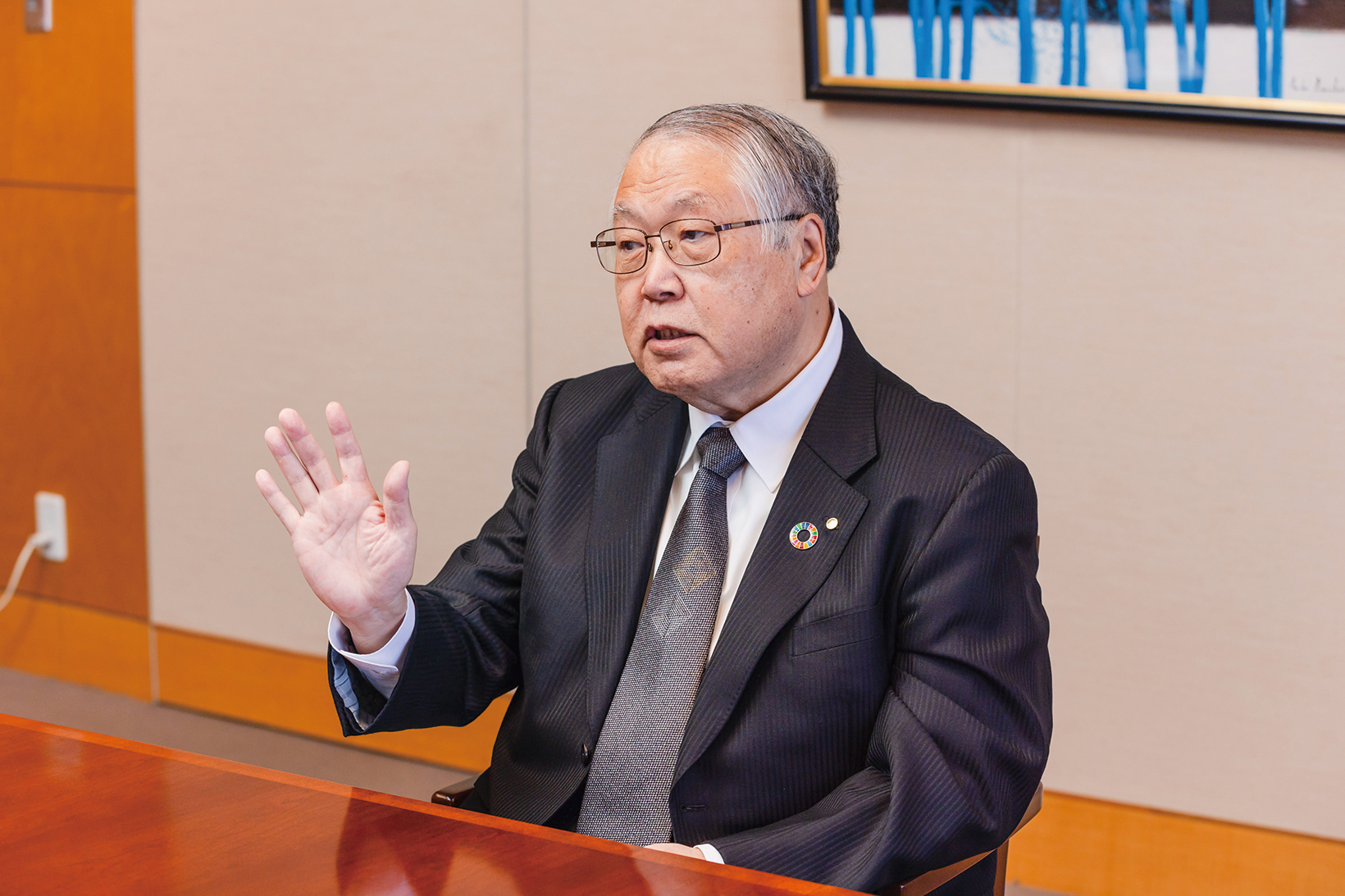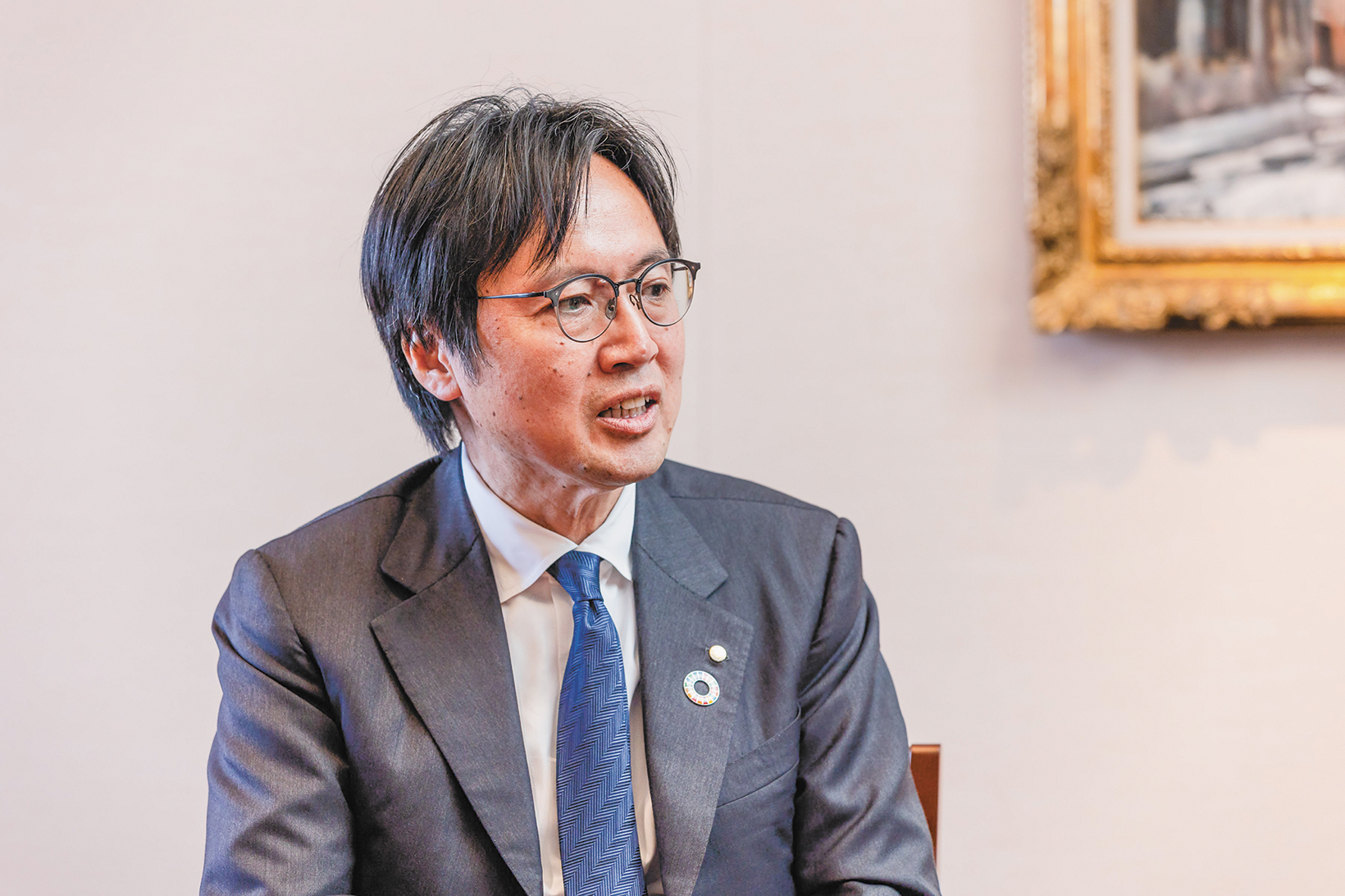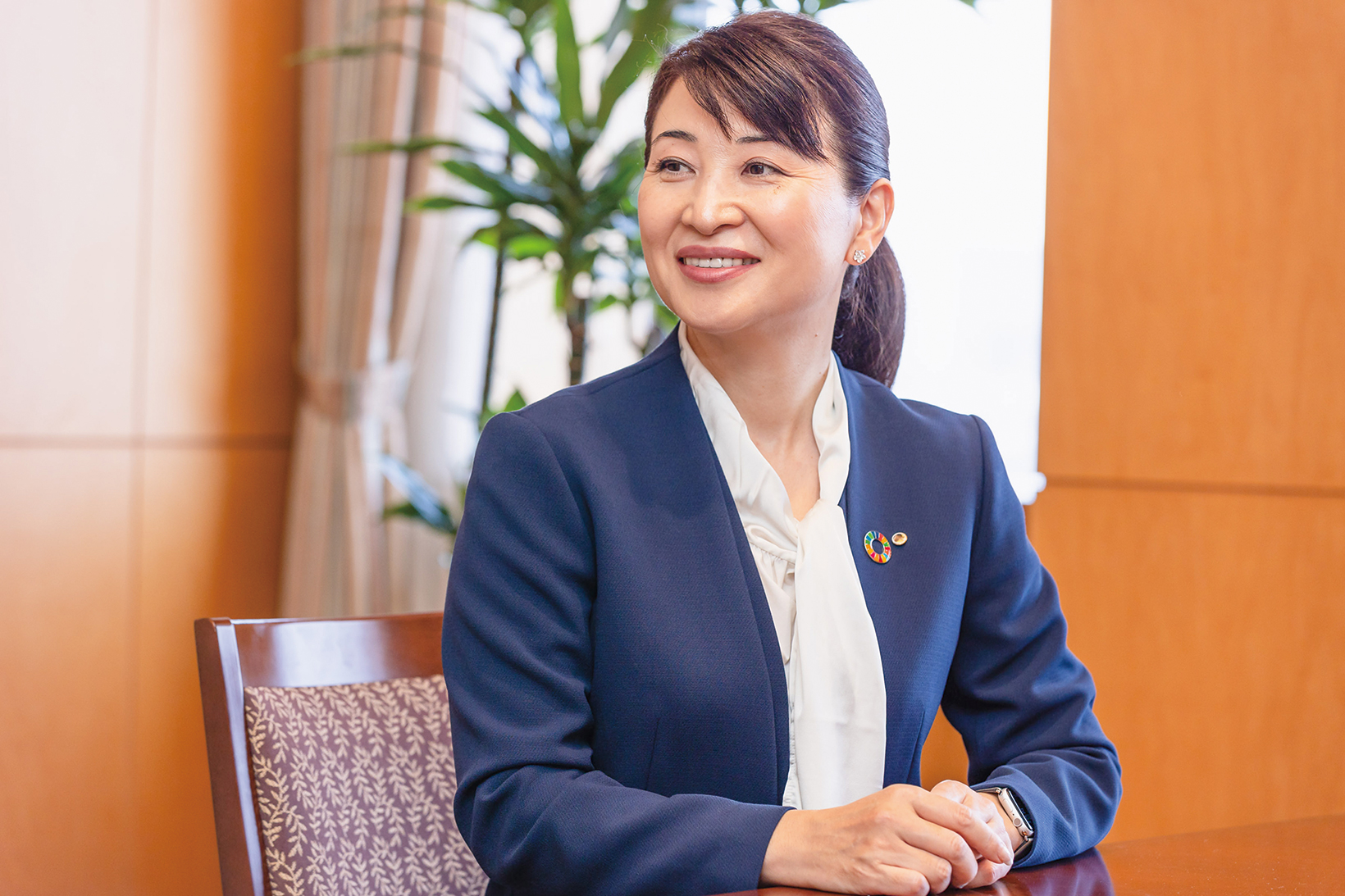Investor Relations(IR)
Integrated Report
Conversation with External Directors
We will continue to strengthen our governance structure as we move toward transforming into a financial services group for a new era

At Orico Group, we aim to further enhance corporate governance by appointing External Directors with a wide range of knowledge and experience. We held an honest discussion about the governance reforms we have been working on and our future goals.
*Contents of the conversation at the time of September 2023.
Our Company kicked off the medium-term management plan in fiscal year 2022. Can you talk about how you've been involved in shaping this plan, and how you evaluate the details and the creation process?
Matsui: In preparation for this iteration of the medium-term management plan, the members of the Board of Directors, including us External Directors, held off-site meetings for several months where we freely exchanged ideas. As a result, I believe we've been able to formulate a business strategy fit for Oricoʼs new era, one that incorporates not only the feedback from the management team, but also discussions with External Directors. I think the plan firmly expresses the direction we wish to head in to transform Orico into a financial services group for a new era.
Nishino: Exactly. In the process of formulating the plan, we all reconsidered what kind of company Orico is, what it should be, and where it's headed, clearly defining our Corporate Philosophy and materiality, and considering the positioning and unified evaluation axis of each business. As a result, I believe we've determined the direction to head in amid changes in the external environment, such as digitization.

Ohgo: During the process of formulating this medium-term management plan, we broke our business down into over 50 units along the two axes of risk return and cost return based on discussions at these off-site meetings. We color-coded them clearly to indicate whether they belonged to the “focus”, “maintain”, or “reduce” groups. Itʼs significant that we were able to show that our areas of focus are the settlement and guarantee business and overseas business. Also, nearly all full-time employees underwent digital training as part of our digital strategy, with over 1,000 employees volunteering to advance to intermediate training after completing the beginner's course, which I think indicates commitment to enhancing their skills as an organization with a clear strategy. I can feel our Company's potential in this area.
Matsui: I think it was a fantastic process that made clear what we have to do and set priorities and direction based on an analysis of our materiality.
Nishino: There are six key management issues that comprise our materiality, but as an example, one of these, “Creating new customer experience value through the use of financial expertise”, has been reinforced in terms of exploring new customers, improving individual understanding of digital technology, and devising new services. Another materiality, “Focusing more on diversity, employee-development, and work-style reforms”, is also being put into concrete action to maximize the potential of our staff, with adjustments in personnel placement, compensation revision, and other areas to create a more fulfilling work environment. I think we have ensured the comprehensiveness of our materiality in conjunction with our Corporate Philosophy based on our goal of achieving both a sustainable society and our sustainable growth.
Ohgo: For financial services, we have to consider long-term profits, and management accounting is not easy due to overlapping revenues and costs from multiple business lines, such as the installment credit and credit card businesses. However, the head of the Finance Group was focused on breaking down costs while getting sites involved in preparation for the medium-term management plan, allowing the cost return and risk return to be calculated and leading to a discussion of policies such as the “focus”, “maintain”, and “reduce” approach. I think the fusion of scientific analysis with Orico's corporate culture of unity through heart-to-heart communication has been conducive to mutual discussions.
Matsui: Indeed. As an External Director deeply involved from the planning stages of the medium-term management plan and shouldering significant responsibility, I will closely monitor and supervise the management team through the Board of Directors to ensure proper implementation going forward. At the same time, I'd like to actively share my opinions and contribute to enhancing Orico's corporate value.
Compared to Orico in the past, what progress do you feel has been made through Board of Directors meetings, offsite meetings, and the like?

Ohgo: Compared to 2014, when I assumed the positionof External Director, there are now five External Directors, allowing a diverse range of opinions to be shared based on individual expertise. I feel that now we can have thorough discussions and figure out the correct direction to head in. The materials for the Board of Directors have been significantly enhanced as well.
Nishino: Iʼve been an External Director since 2019. I receive clear materials ahead of time, and I'm also briefed on important items beforehand. Also, offsite meetings and other various opportunities provide plenty of chances for us to deepen our understanding of the Company. A culture has been fostered where External Directors find it easier to voice their opinions.
Matsui: The viewpoints raised at the Board of Directors are given serious consideration, and there have been instances where they were re-examined within the Company and approved in a more refined form. This makes me feel an increased sense of purpose in my role as an External Director and motivates me to improve the Company. I believe that the smooth communication we have with the executive side is generating positive synergy.
Ohgo: Indeed. The transparency of the medium-term management plan formulation process has improved as well. Generally, discussions about scaling back business activities can be challenging, but acknowledging and preparing for this contraction from two fronts was a significant step forward.
Nishino: Now that weʼve built a commendable strategy, the focus has shifted to the execution needed to achieve it. By cultivating digital talent and utilizing our HR strategy, we are enhancing employees' skills and motivation. As the External Directors work together with the executive side, management, and employees, we will help the Company achieve its vision by offering advice based on our respective areas of expertise.
Matsui: If we view strategy as a unified vision and tactics as the means to achieving it, wisdom becomes the key to executing those tactics. Our Company attracts diligent, hard-working, and motivated individuals, so integrating employees' insights and ideas into management is the essence of our leadership. We have also seen success in new business domains, so I look forward to seeing what innovations emerge in the future.
Ohgo: I often hear people say that Orico is going to become a tech company. If thatʼs the case, not only should we increase recruitment of science and tech professionals, but we must also foster an open environment where people with varied skills and backgrounds, including mid-career hires and freelancers, can flourish.
Nishino: Exactly. Not being restricted by traditional commercial practices and ways of conducting business while fostering personnel and embracing an open working culture, including side-jobs or concurrent jobs, is essential for creating new services and even entirely new business models. Within this framework, Iʼm hopeful that weʼll be able to craft a business model appropriate for Orico as a leading tech company for the next generation.
How do you assess our governance structure?
Matsui: Last June, we moved to a company with an Audit and Supervisory Committee, resulting in a robust governance framework. This structure combines proactive governance led by the execution team and protective governance centered around the Audit and Supervisory Committee, strengthening it in unison. The Audit and Supervisory Committee, consisting of three External Directors and two full-time internal Directors, a total of five members, works diligently to enhance the effectiveness of audits. This is achieved by conducting organizational audits through information from the internal control division, as well as actual audits performed by full-time Audit and Supervisory Committee Members. One year after the change in the governance structure, we have concluded that our goal of enhancing governance has been successfully achieved.
Ohgo: The separation between the executive and supervising sides has allowed for an increase in decisions made by the President and Representative Director, resulting in more rapid decision-making. Additionally, discussions within the Board of Directors have become focused on crucial matters, with an increase in more medium- to long-term perspectives. I feel like our management approach has undergone a significant transformation.
Matsui: Risk management, compliance, and internal auditing have become more transparent. There are also more opportunities to communicate with Directors outside of Board meetings, which helps with auditing the appropriateness of management.
Nishino: While company audits have consistently been conducted by auditors in an effective manner, ever since moving to an Audit and Supervisory Committee, the Committee has carried out more in-depth evaluations of the management's appropriateness, thus ensuring meticulous and independent management oversight. The increase in the number of External Directors has also contributed to diversifying the Board.
Finally, do you have a message for our stakeholders?

Nishino: I believe the role of an External Director is to provide feedback for the sake of the future of the Company by drawing upon insights and experience nurtured in an external environment from an objective standpoint. As someone specializing in business administration and business models, and—while this isnʼt a specialty per se—as a woman, I intend to contribute to a better future for our Company, which includes addressing challenges such as improving the ratio of female managers.
Ohgo: As I embark on my tenth year as an External Director and as it gradually becomes harder to remain independent, I'm looking ahead to the next ten years with intent of leveraging my network to support new business domains and DX. A key issue this year is our relationship with Mizuho Bank. We must establish a cooperative and collaborative relationship while maintaining independence as a listed company on the Tokyo Stock Exchange's Prime Market.
Matsui: Our Company, with its long history and high social credibility, must be wary of being constrained by past precedents or various entanglements. However, "Transformation Now!" is exactly what is being demanded of Orico now. We External Directors have been deeply involved from the planning stages of the current medium-term management plan. Given the magnitude of this responsibility, I believe we must supervise and monitor management through the Board of Directors to enable it to properly implement this plan, as well as actively voice our opinions to help enhance corporate value. The fundamental position of an External Director focuses on monitoring management and maintaining a healthy tension with the executive side. In addition, besides providing feedback on management decisions from a broad stakeholder perspective, our Company consists of External Directors with remarkable skills, and harnessing the abilities of every External Director will enhance the Company's strength. Personally, as a legal expert, I wish to continue keeping watch particularly when it comes to areas such as corporate misconduct and crisis management.